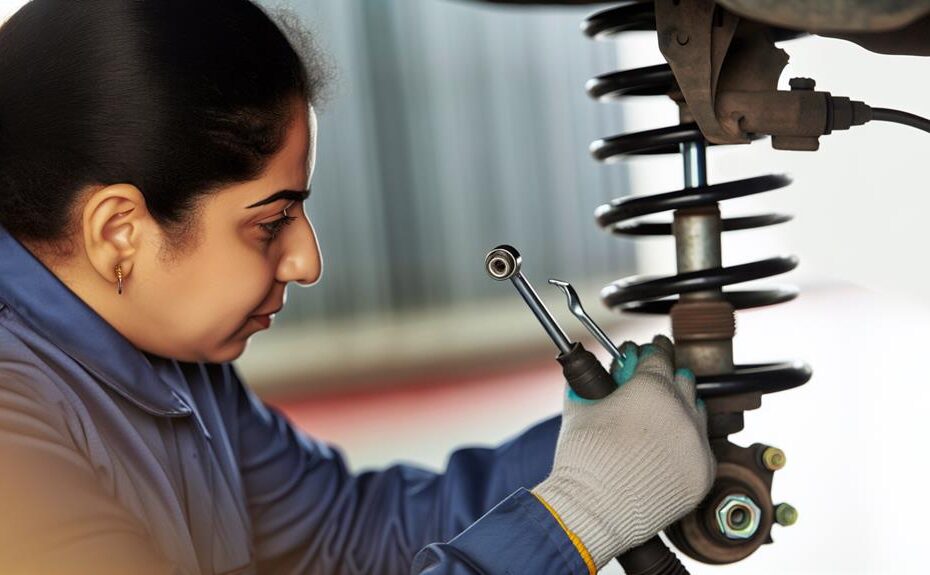Did you know that over 60% of car owners experience some kind of suspension problem within the first five years of owning their vehicle? That's a staggering number, considering how crucial the suspension system is for a smooth and safe ride.
From uneven tire wear to excessive bouncing or vibrations, suspension issues can cause a range of problems that not only affect your comfort but also impact the overall performance of your car.
But fear not, because in this discussion, we will provide you with expert insights on troubleshooting common car suspension problems.
So, if you want to ensure a smooth and enjoyable driving experience, keep reading to discover some valuable tips and tricks to address these issues effectively.
Key Takeaways
- Uneven tire wear can indicate problems with tire alignment or suspension, so it's important to regularly check and maintain these components.
- Excessive bouncing or vibrations may be a sign of damaged shock absorbers or worn-out suspension bushings, which should be inspected and repaired by a qualified mechanic.
- Pulling or drifting to one side can be caused by alignment issues or road camber, so it's crucial to have your car inspected by a professional to identify and address these issues.
- Noisy suspension components, such as clunking or squeaking sounds, can indicate loose or worn-out parts that need to be inspected and diagnosed by a professional mechanic.
Uneven Tire Wear
If you notice uneven tire wear on your vehicle, it's important to address this issue promptly to prevent further damage and ensure optimal performance.
Uneven tire wear can be a sign of a problem with your tire alignment or suspension. Tire alignment refers to the adjustment of the angles of your tires to ensure that they're parallel to each other and perpendicular to the ground. Proper alignment is crucial for even tire wear and maintaining stability while driving.
Suspension maintenance, on the other hand, involves the inspection and repair of components such as shocks, struts, and springs that support the weight of your vehicle and provide a smooth and comfortable ride. A worn-out or damaged suspension can cause your tires to wear unevenly.
To troubleshoot uneven tire wear, you should first have your tire alignment checked by a professional. They'll use specialized equipment to measure and adjust the angles of your tires as needed.
If the alignment isn't the issue, then a thorough inspection of your suspension components is necessary. Look for any signs of damage, such as leaking shocks or worn-out springs.
Addressing these issues promptly won't only ensure even tire wear but also improve your vehicle's overall performance and safety.
Excessive Bouncing or Vibrations
Excessive bouncing or vibrations in your car can indicate a potential problem with the suspension system that should be addressed promptly to ensure a smooth and comfortable ride. When you experience these issues, it's important to investigate the cause and take appropriate action.
Here are some possible reasons for excessive bouncing or vibrations:
- Damaged shock absorbers: Shock absorbers play a crucial role in controlling the movement of your vehicle's suspension. When they become worn or damaged, they can't effectively absorb the impact of bumps and uneven terrain, resulting in excessive bouncing and vibrations.
- Worn out suspension bushings: Suspension bushings are responsible for connecting various components of the suspension system. Over time, these bushings can wear out, causing excessive movement and vibrations. This can lead to a bumpy and uncomfortable ride.
- Other worn or damaged suspension components: In addition to shock absorbers and bushings, other components of the suspension system, such as springs and struts, can also contribute to excessive bouncing and vibrations when they're worn or damaged.
If you're experiencing excessive bouncing or vibrations in your car, it's recommended to have your suspension system inspected by a qualified mechanic. They can diagnose the specific issue and recommend the necessary repairs or replacements to restore a smooth and comfortable ride.
Pulling or Drifting to One Side

When your car pulls or drifts to one side, it indicates a possible issue with the suspension system that requires attention. This problem typically occurs due to alignment issues or road camber.
Alignment issues refer to the misalignment of the wheels, which can cause the car to veer off in one direction. Road camber, on the other hand, refers to the slope or banking of the road surface. If the road isn't level, it can cause the car to drift to one side.
Alignment issues can occur due to various factors such as hitting curbs or potholes, worn-out suspension components, or improper installation of suspension parts. When the wheels aren't properly aligned, it can lead to uneven tire wear, decreased fuel efficiency, and compromised handling and stability.
Road camber is a common issue that can affect the car's trajectory. The slope of the road surface can cause the car to naturally drift towards the lower side. This is particularly noticeable on roads with a significant camber.
To address these problems, it's essential to have your car inspected by a professional mechanic. They'll be able to determine if there are any alignment issues and make the necessary adjustments. Additionally, they can check the suspension components for wear and tear and replace them if needed.
Noisy Suspension Components
Suspension components that produce noise can be indicative of underlying issues that need to be addressed. When you start hearing strange clunking sounds or notice squeaking suspension components, it's time to take action. Here are a few things to consider:
- Loose or worn-out suspension components: Loose or worn-out components can cause clunking sounds when driving over bumps or uneven surfaces. This could be due to worn-out bushings, ball joints, or control arm bushings.
- Damaged or worn-out shocks or struts: If your shocks or struts are damaged or worn-out, they may produce squeaking or creaking sounds when the suspension is compressed or extended. This can affect your vehicle's handling and ride comfort.
- Improperly lubricated suspension components: Lack of lubrication can cause squeaking sounds when the suspension moves. This can be due to dry or worn-out bushings, control arm joints, or sway bar links.
It's important to address these issues promptly to ensure the safety and performance of your vehicle. Have a professional mechanic inspect and diagnose the problem to determine the best course of action. Don't let noisy suspension components hold you back; take control and liberate yourself from potential problems on the road.
Difficulty Steering or Handling

If you encounter difficulty steering or handling your vehicle, it could be indicative of underlying issues that require immediate attention. Steering responsiveness and suspension alignment are two key factors that contribute to the overall handling of your car. When these components are not functioning optimally, it can lead to a compromised driving experience and even pose safety risks.
To help you understand the importance of steering responsiveness and suspension alignment, here is a table outlining their effects on your vehicle:
| Steering Responsiveness | Suspension Alignment |
|---|---|
| Determines how quickly | Ensures that all four wheels |
| the car responds to | are properly aligned and |
| your steering inputs | parallel to each other |
| and changes in direction. | for optimal stability. |
| A delay in response can | Misaligned suspension can |
| make it challenging to | cause uneven tire wear, |
| navigate corners or | poor handling, and a |
| avoid obstacles. | rough ride. |
If you notice any difficulties with steering or handling, it is crucial to have your vehicle inspected by a professional. They will be able to diagnose and address any issues with steering responsiveness or suspension alignment, ensuring your car performs optimally and keeps you safe on the road.
Frequently Asked Questions
What Are the Common Causes of Uneven Tire Wear and How Can It Be Prevented?
To prevent uneven tire wear, diagnose excessive bouncing or vibrations in your car. This can be caused by worn-out suspension components or improper wheel alignment. Regular maintenance and timely repairs can help prolong tire life.
How Can Excessive Bouncing or Vibrations in the Car Be Diagnosed and Resolved?
To diagnose and resolve excessive bouncing or vibrations in your car, expert tips recommend checking for worn out shocks or struts, loose or damaged suspension components, and unbalanced wheels or tires. Proper maintenance and repairs can effectively fix car suspension problems.
What Are the Possible Reasons for a Car Pulling or Drifting to One Side, and What Steps Can Be Taken to Fix It?
Is your car pulling or drifting to one side? This could be due to a misaligned car or improper tire pressure. To fix it, get your car alignment checked and adjust tire pressure accordingly.
How Can Noisy Suspension Components Be Identified and Fixed?
You can identify and fix noisy suspension components by listening for squeaks or rattles while driving. Worn out shock absorbers can be replaced to improve suspension performance and reduce noise.
What Are the Potential Reasons Behind Difficulty Steering or Handling, and What Can Be Done to Improve It?
Having difficulty steering or handling your car? There could be various reasons behind it, such as worn-out suspension components or improper wheel alignment. Diagnose and resolve the issue by replacing worn parts and getting a professional alignment.
Conclusion
In conclusion, addressing and resolving common car suspension problems is crucial for maintaining a smooth and safe ride. By identifying issues such as uneven tire wear, excessive bouncing or vibrations, pulling or drifting to one side, noisy suspension components, and difficulty steering or handling, car owners can ensure optimal performance.
Just as a skilled conductor orchestrates a symphony, a well-functioning suspension system harmonizes the car's movements, providing a seamless and enjoyable driving experience.
